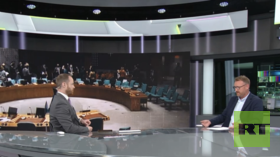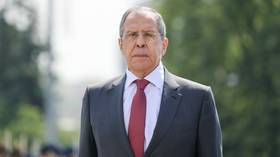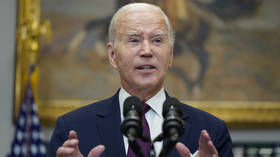Over the past several days, we have heard a great deal about the outstanding achievements of the Wagner Private Military Company on the field of battle. Their victory in the months-long bloody fighting to take Bakhmut/Artyomovsk and Soledar brought them respect throughout Russia which has even outlasted the disgrace that Wagner boss Yevgeny Prigozhin brought on their heads by his reckless armed mutiny over the past weekend.
Indeed, in his address yesterday to military commanders who had stood in the path of Wagner’s march on Moscow and forced Prigozhin to negotiate a settlement, President Vladimir Putin acknowledged that the Wagner Group had shown greater effectiveness on the field of battle than the Ministry of Defense’s own regular troops.
That remark struck me as something rather peculiar to say to officers who had just saved the Kremlin from the prospect of a disastrous bloodbath at the gates of Moscow. Perhaps it was said to soften the shock of Putin’s next statement, when he detailed the amount of money that the Russian government had paid to Wagner in the year May 2022 to May 2023, namely one billion euros in ruble equivalent, for both maintenance of the force and for incentive rewards which came to 20% of the total.
However, as I reflect upon it, I conclude that Putin’s intended audience was not in the room but overseas, in the intelligence agencies in London and Washington, to give them and the leaders they report to the false hope that the Russian military will now be weakened by the disbandment of the Wagner Group.
I say this because official Russia is very circumspect in describing what is happening and what is likely to happen on the field of battle in Ukraine. Yes, they announce the horrific casualties being borne by the Ukrainian army and the destruction of Western tanks, artillery and armored personnel carriers in the first two weeks of the Ukrainian counter-offensive. But they remind themselves that the Ukrainian reserves have been held back till now and may be unleashed at any time, with unpredictable results. On the Russian side, there is absolutely no crowing “Mission Accomplished” in the typically American fashion of George W. Bush at a premature moment in the Iraqi war.
And yet, if you look closely at the daily reports of the Russian military on battlefield operations, you have to recalibrate our understanding of who is who, where the strengths of Wagner end and the strengths of the Russian regular Army begin.
The Wagner Group made their mark in the battle for Bakhmut, which was largely a war of street fighting and that is always bloody. Despite the artillery advantage of the Russian forces, taking building after building and street after street was costly in lives. It is easy to imagine that Russian losses were not less than Ukrainian losses. For the Russians that was politically acceptable only because most of the Wagner troops engaged in the fighting were liberated prisoners whose lives were expendable, as seen from Moscow. Then for other special missions there were the Chechens of the Akhmat special forces, who did wonders to liberate Mariupol.
However, battlefield operations in Ukraine are now proceeding in a very different manner, that of traditional war of attrition in which artillery strength is determinant. From the very beginning of the Special Military Operation, Russian soldiers were the operators of the tanks, drones and other heavy equipment while a lot of the infantry fighting was being done by the Donetsk and Lugansk militias, These were hardened fighters defending their own land. But, as seen from Moscow, they also were more easily expendable than, say, reservists or even contract soldiers from Moscow, or Kazan or Vladivostok. During 2022, the regular Russian army was at a disadvantage to the Ukrainian side in terms of real time reconnaissance of enemy positions for purposes of targeting. The Ukrainians were receiving such data from the American planes and satellites. Moreover, the Russians were not very skilled in tank maneuvers and repeatedly fell into Ukrainian traps or were destroyed by anti-tank weapons provided by the West.
In 2023, we see that the situation has reversed itself. The Russian Army has learned to work with drones very effectively. Whatever shortages in drones they may have had at the outset of the war have been compensated by vastly expanded production from the military industrial complex and also from what might be called ‘handicraft’ production both by start-up companies on the home front or by improvised assembly by troops themselves close to the battle lines.
We have seen on Western television many reports of Russian drone attacks on Ukrainian cities and critical infrastructure. Initially such drones were largely imported, from Iran and other sources. Today they surely are mostly Russian produced.
But these attacks on cities are only a side-show in this war compared to the reconnaissance and kamikaze drones that the Russian Army is now deploying on the battlefield. The Russian soldiers have perfected the coordination of both types of drones to achieve proven success in destroying both the latest NATO heavy equipment and the older Soviet vintage equipment that Kiev is moving to the front in its so-called counter-offensive.
Today’s Russian news portals provide reports and video images of the destruction of an American supplied Bradley armored personnel carrier by a Russian T-80 tank at a distance of 9.5 kilometers using drones in tandem to locate the hidden target, provide coordinates for precise cannon fire and record the explosion of the target vehicle. This, of course, is an entirely new method of tank warfare that requires computer savvy personnel and highly sophisticated communications.
In his Evening with Vladimir Solovyov show on a succession of Sundays, the host has put up on the screen videos taken during his meetings with officers and rank in file soldiers at the front lines in Donbas. Most recently one show was devoted entirely to the soldiers operating the drones and to their colleagues manning the artillery and tanks.
In addition to drones, the Russian Army is now using attack helicopters, primarily the so-called Alligators, to destroy Ukrainian heavy equipment on the battlefield. The risks of ground fire or missiles attacking the helicopters have been mitigated by a variety of new electronic warfare devices that appear to be very effective in practice. And electronic warfare is being used by the Russians to disorient and otherwise neutralize Ukrainian drones.
At the same time, the Russian military is very quietly telling us that it is now deploying stealth bombers into the war zone. Initial flights have demonstrated their ability to operate over Ukrainian controlled territory without being detected. If this practice is now generalized, the Russians will finally enjoy the air superiority that has been the feature of US and NATO operations in war over the past thirty years or more.
The most sensational results of the new Russian ways of warfare make it into Western tabloids and television broadcasts because the destruction of Bradleys and Leopards is news-worthy in the supplier countries. These advanced systems are being targeted in a priority fashion by Russian soldiers and airmen because of the high rewards that the Ministry has posted. As part of the process of documenting ‘kills,’ the incidents of destruction are video recorded and put on social media by the Russians. What is missing in our coverage is any overview of what this means for our evaluation of the military potential of the Russian army.
Neutralizing the Ukrainian tanks, armored personnel carriers and artillery pieces means removal of the most talented, trained and experienced Ukrainian soldiers and officers. It exposes the infantry to ever more horrific losses as the counter-offensive proceeds at the demand of the paymasters in Washington, Brussels and London.
*****
Now let us consider the implications of the foregoing for the end game of this war.
So far in the counter-offensive that began on 4 June, the Ukrainian side has lost nearly 20% of the Bradleys supplied by the USA and about the same percentage of Leopards supplied by the European NATO member states. The latest information from the USA on the next tranche of military assistance to Kiev indicates a one-for-one replacement of the heavy equipment being lost on the battlefield. Note: one-for-one! The Ukrainian forces will not gain any advantage over the losing hand they now seem to have. The conclusion that I draw from this is that regardless of what Washington declares about the long-term future of the war, it has already written off the Ukrainian army’s chances of succeeding in its mission of liberating its territory from Russian occupation.
As for personnel, two weeks into the counter-offensive the Russian military command reported to Putin that the Ukrainians had lost 13,000 soldiers and officers. By daily accounts since then, we have been told that 500 or more Ukrainian fighters have been killed daily on the several fronts where they have been making concentrated attacks. A report today in Forbes confirms that the Russian mine fields and other defenses which stand in the way of the attacking Ukrainians have led to disastrous personnel losses.
In fact, the United States may have written off the Ukrainian army’s existence entirely. Rumors abound that during Polish President Duda’s last visit to Kiev he and Zelensky laid down plans for Polish troops to enter Western Ukraine in July-August to back-stop the Ukrainian military. If there is any substance to this, it confirms the suspicion that there will no longer be a Ukrainian army worthy of the name by that time due to deaths and injuries, but possibly also to another consequence of the very high casualty rate that many Ukrainian units are now experiencing: in the disabled Ukrainian units soldiers may finally turn on their officers in desperation. Up to now, Ukrainian soldiers on the battlefield who have seen what awaits them and have made moves to surrender were being shot in the back by the Ukrainian National Guard.
The possibility that there are legs under the rumor of Polish plans to send troops into Western Ukraine is supported by other rumors concerning the whereabouts of Wagner Group forces that have left Russia for Belarus and are being redeployed near the borders with Poland and Western Ukraine.
For those who are alarmed at Polish entry into the war moving us closer to a general European-wide war and likely escalation to nuclear strikes, I offer the “consolation” that Poland’s possible engagement in Ukraine does not engage Article 5 obligations of the North Atlantic Alliance treaty. It would be a Polish-Russian war, and possibly would be limited only to fields of battle in Ukraine. Full stop. And even if the battle improbably expanded to Polish territory, I do not envision Germany putting Hamburg in jeopardy for the sake of defending Wroclaw (Breslau) or Warsaw from the Polish leadership’s delusional adventure.
*****
A few days ago, the dean of the Realist School of International Relations in the United States, Professor John Mearsheimer of the University of Chicago, posted on his substack.com site an article entitled “The Darkness Ahead: Where the Ukraine War is Headed.” This is obviously an essay in which he has invested a great deal of time and thought, since he remarks at the very end that he will be using it as the basis for public lectures he will be delivering in coming months.
This essay bears all the hallmarks of a professional political science document. It sets out a long series of scenarios that describe possible eventualities. It makes the argument that since both Ukrainian and Russian sides see their confrontation as existential, neither side will come to the negotiating table. For that reason the war will, in Mearsheimer’s view, end in a frozen conflict that may flare up again in the future. In the meantime, Russia’s relations with Europe and the Collective West will stagnate at their present state of rupture, and the European economies will continue to suffer the consequences of their sanctions on Moscow.
It is most curious that the good professor has not faced up to the “elephant in the room,” namely the possibility of Ukrainian military collapse and the conclusion of a peace on terms of capitulation to Russian demands.
I have mentioned above the very unfavorable casualty rate of Ukrainian forces at present when facing the much stronger Russia and much more technologically capable Russian Army that has emerged from a year of fighting. Mearsheimer himself describes the ongoing war of attrition as a war decided by artillery in which, per his admission, the Russians have a 10 to 1 advantage in terms of artillery tubes and shells. He goes on to say that given the limitations of Western stocks and manufacturing capacity, there is no way to improve the Ukrainians’ odds in terms of artillery in the coming year.
Curiously, Mearsheimer chooses to set Russian losses of personnel at 1:2 whereas by his own logic it should be 1:5 if not 1:10. He also remarks on the population advantage of Russia, which he now sets at 5:1, taking into consideration the flight of Ukrainians abroad, including the 4 million who have moved to Russia proper.
So, let’s draw the appropriate conclusion from the very facts that Professor Mearsheimer has given us: Ukraine is about to be militarily obliterated, and that suggests a capitulation, whatever Washington wants or hopes for. Moreover, with the Wagner Group breathing down their necks from just across the border on the Belarus side, it would be utter madness for the Poles to proceed with their “rescue” of their Ukrainian friends, which more realistically could be called an occupation of defeated Ukraine.
Time will tell. But at this moment, time is very much favoring the Russian cause.
©Gilbert Doctorow, 2023
https://gilbertdoctorow.com/2023/06/29/regular-russian-army-fast-becoming-worlds-most-powerful-military-in-ground-combat/ 




